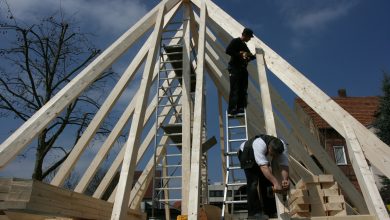Easy and Eco-Friendly Renovation Guide

If you think about it, renovating an existing house is more sustainable than constructing a new one. Since you’re not building a structure from scratch, you don’t have to buy as many materials. It also allows you to give an old home a new lease on life, instead of tearing it down, disposing of the debris, and producing construction waste.
In this article, we’ll guide you on how to make your renovation guide be more eco-friendly without sacrificing style or function. We’ll also provide tips on how to save money and improve energy efficiency throughout the project.
Before renovation
An eco-friendly home should be made with sustainable and energy-efficient materials, equipment, and processes. It should be designed to help homeowners lower energy bills and minimise their impact on the environment.
Let’s begin with practical purchases.
If you want to be an eco-conscious consumer, you should understand that certain purchases are necessary while others aren’t. Focus on finding out where and how the item was produced. This will make it easier for you to make better home renovation choices.
To start, you can’t go wrong with the three Rs — reduce, reuse, and recycle. These will help you evaluate the items you should be keeping, throwing, and giving away. Here are some tips:
- Assess if you can reuse your appliances, cabinets, windows, doors, and other fixtures. Fixing and painting them might cost less than buying something new. You can give these items a fresh, new look to match the design and colour of your home instead of discarding them.
- Take a trip down to salvage yards or antique shops. A few local materials and items may still be in pristine condition. In particular, look for nice fixtures, doorknobs, and others.
- Before you shop for appliances, make sure that you’ve researched enough information about the item. Does it have a high energy rating or an energy star logo? Which brands are expensive but not costly to maintain? Which item should I buy for fewer energy expenses? Visit some online forums and learn if buyers think they’ve made a good decision for their purchase. After all, good research may come in handy during an engaging sales talk.
- You might want to avoid disposing of items unnecessarily. Some portions of your home, like walls, wood floorings, and trimmings, can be saved and repurposed.
- For extra funds, you can gather items you can sell. You can post them on online marketplaces or buy and sell websites. If you intend to donate, you can keep the things in a box that you can quickly drop off in a shelter.
Consider and embrace passive home design.
Passive home design considers intelligent heating and cooling techniques through every aspect of your home design. You must consider the orientation of your windows, exterior materials and paint colour, and even the location of your backyard or outdoor space. This helps maximise your home’s energy-efficiency.
The key is making intelligent design decisions throughout your home renovation. Here are some ideas:
- Talk to a professional about your intention to build a passive house. Be clear about the changes you want to make and discuss them with professionals. Consulting building design or drafting experts with a clear concept in mind will save you time and energy.
- Skip using papers except when needed. Using your mobile phone, you can download design ideas for inspiration which you can easily forward or email to your designer. It would be a waste to produce printouts now and then, and going mobile is a greener option.
- As much as possible, choose products that you can source locally. This is to reduce transportation costs and save vehicles’ carbon emissions.
- Re-evaluate your energy consumption at home. From an environmentally conscious point of view, determine how you can cut energy costs by making Do-It-Yourself (DIY) home energy assessments. This addresses existing concerns and ultimately decide on upgrades and changes in your home renovation guide.
During renovation
Choose eco-friendly building materials.
If you have a decades-old home, you might discover some materials that can pose health hazards, such as asphalt shingles roofs or other materials that contain mercury and lead.
Some building materials like paint, flooring adhesives and caulking may also contain high amounts of toxic chemicals like benzene, trichloroethylene, etc. Higher benzene concentrations may affect your home’s indoor air quality, leading to issues affecting respiration and circulation. Meanwhile, exposure to materials containing trichloroethylene which you can easily absorb through the skin, may cause cancer.
For your foundation and walls:
- Among building materials that can improve indoor air quality are engineered wood, structural insulated panels, recycled metals, reclaimed wood, and precast concrete slabs.
For your floor:
- Apart from their many uses, you can use reclaimed scaffold boards for your flooring. They can undergo treatment for optimised durability. Not to mention, they’re a cheaper floor option.
For your kitchen and bathroom:
- For a lightweight, durable, and highly renewable material, consider organic bamboo for your benchtop. It has greater compressive strength than brick and concrete, but it has to undergo treatment to be insect-proof.
- You may also consider quartz for its durability. However, the mining practices for quartz may cause air pollution and water contamination.
For your outdoor space:
- Also, an eco-friendly choice is choosing cement made from shredded plastic waste. Its impermeability makes it an ideal outdoor material.
For your roof:
- If you have a damaged roof, you may choose white tiles with a 70% energy efficiency rate. Said tiles reflect heat, keeping a cool temperature inside your home. Otherwise, you can apply white cooling paint, which is readily available. This type of paint can reduce the amount of heat absorbed by the home, lessening the need for additional cooling. Be careful not to use dark paint since it absorbs and re-emits heat trapped in your roof.
- Speaking of colours, certain types are better for specific purposes. It’s essential to know which is which to avoid buying an inappropriate one for a specific painting job. Remember to choose paint with lower Volatile Organic Compounds (VOCs) solvents. They are less harmful but are as effective as traditional ones. If you’re repainting your interiors, you can’t go wrong with white paint as they help your home maintain a bright and airy appearance.
- If you don’t have an expansive outdoor space for a garden, one thing you can consider is a green roof. Surprisingly, dry soil is an effective insulant, so it helps cool or heat your house. You can talk to roofing contractors if building one seems like a project you could be interested in.
Install effective insulation.
- Invest in quality green thermal insulation for your attic, basement, or any room in your house. This prevents your heating system from working twice as hard during the summer, which could affect your energy bills that season. We suggest using straw bales for their non-flammable properties. They’re also cost-effective, renewable, and moisture-resistant.
- Aside from insulation, an effective thermal and sound barrier are double-glazed windows (or dual pane windows). The air bubble trapped between two glass panes helps retain heat or cold, allowing the house to mantain a comfortable temperature.
Assess your plumbing and electrical systems.
As mentioned, you can make DIY energy assessments at home. This is also applicable to your plumbing and electrical systems. You may have to schedule an inspection with a certified plumber and electrician to check whether you can re-engineer and redesign them to accommodate your needs without better sky-high costs.
- You can make use of solar energy by investing in solar panels. It may be costly initially but could pay off in the long run.
- Maximise natural light by installing operative skylights, sun tunnels, glass doors or windows. Such additions can provide light in your home during the day while simultaneously boosting your Vitamin D levels and mood.
- Aside from being 100% recyclable, glass is weather and rust-resistant. It’s also a good insulation material.
- Fluorescent bulbs are known to have a toxic chemical which is mercury. An eco-friendly option is switching to Light Emitting Diode (LED). Since their components are solid and don’t burn out as quickly as fluorescent ones, they can last decades.
- According to Environmental Protection Agency (EPA), traditional flush toilets are one of the primary sources of wasted water in many homes. To address that issue, switch to a low-flow model for your bathroom and shower. The air mixes with the water flow, giving an illusion of a high water flow.
- Additionally, traditional flush uses the same amount of water in disposing of liquid and solid materials. As a solution, upgrade to a dual flush. It helps reduce the toilet’s average water consumption. Make sure to look for products with WaterSense labels, as they are EPA-approved.
After renovation
One of the first things to think about as a home renovation guide comes to a close is how to minimise waste. Here are some things you can try:
- Categorise and sort your waste. You might find materials that can still be repurposed and used as decoration. Sometimes, all you need to do is find an opportunity to be creative. Don’t forget to use eco-friendly materials while doing this painting project.
- Make the switch and use natural cleaning materials. They are plant-based, cruelty-free, and hypoallergenic. Also, they are suitable for the environment compared to regular ones.
- If you have an expansive yard, try composting. It helps reduce waste from your home renovation, improves soil quality, and minimises carbon footprint.
- Lastly, you can place plants inside your home. Indoor plants can provide better air quality and improve your immune system and productivity.
Start a project with the environment in mind
Some may think an eco-friendly home renovation is too expensive to consider. But don’t worry – though the upfront cost may be high, you will enjoy the benefits for many years. Think of it as a wise and practical choice with minimum environmental impact.




